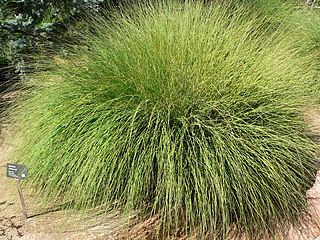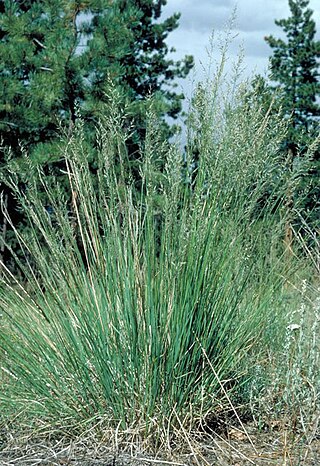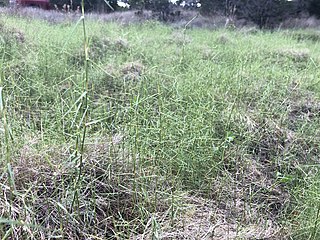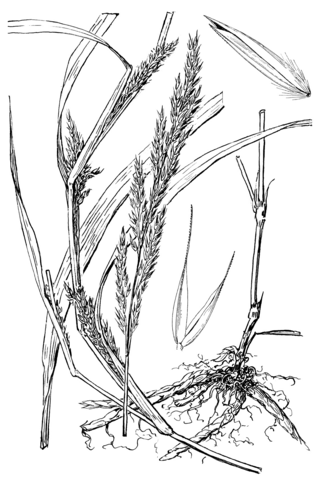
Alopecurus, or foxtail grass, is a common and widespread genus of plants in the grass family. It is common across temperate and subtropical parts of Eurasia, northern Africa, and the Americas, as well as naturalized in Australia and on various islands.

Cynodon is a genus of plants in the grass family. It is native to warm temperate to tropical regions of the Old World, as well as being cultivated and naturalized in the New World and on many oceanic islands.

Monotropa uniflora, also known as ghost plant, ghost pipe, or Indian pipe, is an herbaceous perennial plant native to temperate regions of Asia, North America, and northern South America, but with large gaps between areas. The plant is sometimes completely waxy white, but often has black flecks or pale pink coloration. Rare variants may have a deep red color. The name "Monotropa" is Greek for "one turn" and "uniflora" is Latin for "one flowered" as there is one sharply curved stem for each single flower.

Muhlenbergia schreberi, the nimblewill, is a grass species in the family Poaceae native to North America.

Muhlenbergia rigens, commonly known as deergrass, is a warm season perennial bunchgrass. It is found in sandy or well-drained soils below 7,000 feet (2,100 m) in elevation in the Southwestern United States and parts of Mexico.

Muhlenbergia is a genus of plants in the grass family.

Orobanche uniflora, commonly known as one-flowered broomrape, one-flowered cancer root, ghost pipe or naked broomrape, is an annual parasitic herbaceous plant. It is native to much of North America, where it is a parasitic plant, tapping nutrients from many other species of plants, including those in the families Asteraceae and Saxifragaceae and in the genus Sedum. The name "orobanche" can be translated to "vetch-strangler" and "uniflora" can be translated to "single-flower".

Tussock grasses or bunch grasses are a group of grass species in the family Poaceae. They usually grow as singular plants in clumps, tufts, hummocks, or bunches, rather than forming a sod or lawn, in meadows, grasslands, and prairies. As perennial plants, most species live more than one season. Tussock grasses are often found as forage in pastures and ornamental grasses in gardens.

Crataegus uniflora is a species of hawthorn known by the common name one-flowered hawthorn, or dwarf hawthorn. It is native to parts of the southeastern United States. The plant is usually a small bush, but some forms can be a few meters tall. The flowers occur singly or in small clusters. The fruit are hairy and yellow to reddish in colour.

Muhlenbergia montana, the mountain muhly, is a species of grass. It is native to North and Central America, where it is found throughout the Western United States, the Sierra Nevada, Mexico, and Guatemala.

Muhlenbergia porteri is a species of grass known by the common names bush muhly and Porter's muhly.

Muhlenbergia richardsonis, known by the common name mat muhly, is a species of grass. It is native to North America, where it can be found throughout much of Canada, Alaska, the western half of the contiguous United States through California, and in Baja California, Mexico.

Muhlenbergia utilis is a species of grass known by the common name aparejograss.

Muhlenbergia capillaris, commonly known as the hairawn muhly, is a perennial sedge-like plant that grows to be about 30–90 cm (0.98–2.95 ft) tall and 60–90 cm (2.0–3.0 ft) wide. The plant includes a double layer; green, leaf-like structures surround the understory, and purple-pink flowers outgrow them from the bottom up. The plant is a warm-season grass, meaning that leaves begin growth in the summer. During the summer, the leaves stay green, but they morph during the fall to produce a more copper color. The seasonal changes also include the flowers, as they grow out during the fall and stay healthy till the end of autumn. The muhly grows along the border of roads and on plain prairies. The grass clumps into herds, causing bush-like establishments in the area the hairawn muhly inhabits. The flowers are very feathery and add a cloudlike appearance to the top of the grass. It is native to eastern North America and can be used for a multitude of purposes, including ornamental gardening and farming. It was voted 2012 plant of the year by the Garden Club of America.

Iris uniflora is a species in the genus Iris, it is also in the subgenus Limniris. It is a rhizomatous perennial, from Russia, Mongolia, China and Korea. It has thin grass-like leaves and stems, and purple, blue-purple or violet flowers. It is cultivated as an ornamental plant in temperate regions.

Muhlenbergia frondosa is a species of plants in the genus Muhlenbergia and a member of the grass family. Its common name is common satin grass or wirestem muhly. It is informally grouped with other satin grasses, which are other species in Muhlenbergia. It is a warm-season C4-photosynthetic grass.















